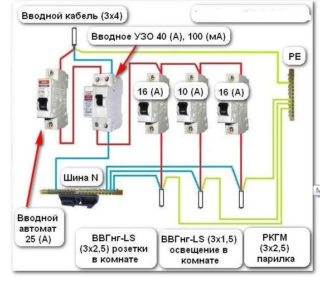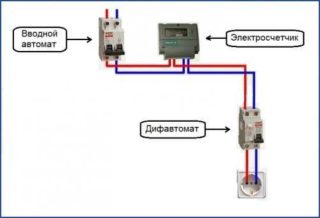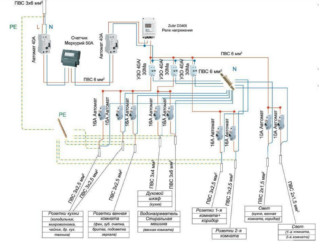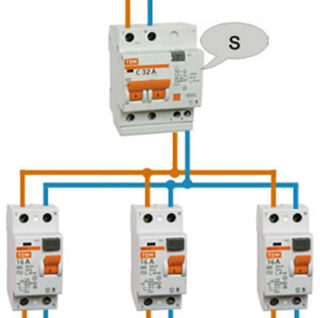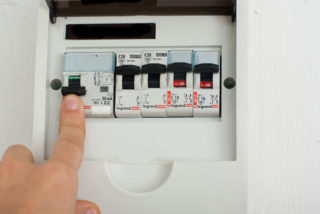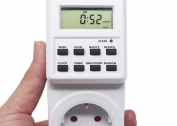An automatic differential switch is necessary to protect the power line from overvoltage and short circuit. The electromechanical device also protects a person from electric shock in the presence of leakage. The connection diagram of the difavtomat is selected taking into account the number of network phases and the specifics of the device (RCD and circuit breaker functions).
Design features of differential automata
 The combined device consists of two main nodes:
The combined device consists of two main nodes:
- A circuit breaker that has two releases. An electromagnetic coil provides power off in the trunk during short circuits. A thermal release in the form of a bimetallic plate is needed to de-energize the network if the load limit increases. Devices have 2 (single-phase network) or 4 poles (three-phase network);
- RCD The protective shutdown element does not allow to disconnect the line due to the relay. A node under normal conditions generates magnetic fluxes of equal strength. In the presence of current leakage, the relay switches, disconnecting the mains.
In addition to RCD and AV, the difavtomat includes a differential transformer and an electronic amplifier.
Advantages and disadvantages of devices
Differential automatic machines under conditions of correct installation provide reliable protection of the power line. When buying a device with a nominal current parameter of 16, 20, 25, 32 Amps, an additional RCD is not needed.
The disadvantages include the lack of a marker marker on models of some manufacturers. Without this designation, it is difficult to establish the reason for turning off the power.
Current parameters for domestic networks
According to the current parameters for tripping protection devices are divided into classes:
- B - permissible load 5 times;
- C - permissible load 10 times;
- D - permissible load of 20 times.
With a minimum capacity of equipment, B-class devices are suitable, for an apartment or a private house - C-class.
For household power lines, C16 difavtomats are mainly used. When organizing lighting, models with a current leakage rating of up to 30 mA are used. Single lines are equipped with 10 mA devices. At the input, you can put devices with a leakage current of up to 300 mA.
Installation of a difavtomat in a three-and single-phase network
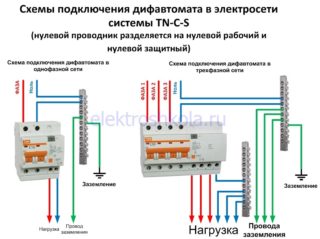 Installation of the device begins by checking the response to leakage. The user will need to press the Test button, creating an artificial leak. The device should react, i.e. turn off. If he continued to work in test mode, you cannot use the machine.
Installation of the device begins by checking the response to leakage. The user will need to press the Test button, creating an artificial leak. The device should react, i.e. turn off. If he continued to work in test mode, you cannot use the machine.
For a single-phase network with a voltage of 220 V, a two-pole AVDT is used:
- the neutral wire from the load is connected from below;
- Power neutral pops up.
The three-phase type of network with an operating voltage of 380 V provides a four-pole device connected by a similar principle. During installation work, it should be borne in mind that the bulky differential protection block will take place in the shield.
Devices marked 230 / 400V may be connected to a single and three-phase network. In the latter case - to a separate equipment or outlet group.
Rules for choosing a connection scheme
When connecting a difavtomat, you need to be guided by the network parameters, the type of room and financial capabilities.
Easy connection
A house in the countryside or a summer house does not need a large number of devices. In a summer house, it is enough to put one device at the input and output separate lines for the lighting system and outlets.If there is a current leakage on any line, the common high-voltage circuit-breaker will operate by de-energizing all the lines.
Until the end of the breakdown in the house there will be no electricity.
Reliable connection
In an apartment or country cottage for risk groups, you will need to connect separate devices. A bathroom, a kitchen, and appliances using water require increased security. For "wet groups" a separate wiring is organized with an individual diatom. At the moment of operation, the device deenergizes only the problem segment, the rest of the network operates in normal mode.
Branched Network Protection
For a complex power line, class S or G diphatoms will be needed. They have a linear connection principle:
- a separate machine for a group of consumers;
- individual machine for high-power consumer.
At the moment of operation of one linear device, the others will function normally. The reason is the delay in the response time of the machine to the input.
Wiring diagrams
Regardless of the circuit, the automatic devices are connected to the phase or neutral of only that circuit, for the protection of which they are needed.
AEDT on input
The device is installed in the shield and protects the wiring branches and the groups to which they are thrown. The introductory machine must be selected taking into account the power and operating features of the network. First, a counter is set, and then the device. All electrical circuits are fed to the output of the AVDT. An individual limit switch is mounted for each circuit.
The current load must be selected taking into account the power of a single-use household appliance and the parameters of the electric meter. The machine must fire earlier than the fuse of the accounting device.
This connection has several advantages:
- saving money on the purchase of one device;
- compact dashboard - the machine does not take up much space.
Disadvantages of connection - a long search for a faulty branch, the reasons for the failure and a complete blackout of the room in case of problems.
Two-level connection
Connect the machine to the branched network in tiers. At the first level, after the counter is placed AVDT - the main load passes through it. Output cables are thrown on the machines according to the number of room circuits.
At the second level, you can connect low-power devices with a minimum threshold for current leakage. A separate circuit will need to be allocated for a washing device, a jacuzzi, a shower cabin with electric heating.
A two-tier system has several advantages:
- safety - the network is protected from voltage surges and short circuit;
- reliability - the first-level device duplicates the work of subsequent RCDs and turns off the energy simultaneously with them;
- quick detection of a faulty area;
- blackout only one room at the time of repair;
- the possibility of implementation with a multi-circuit branched line.
The minus of the scheme is the cost of acquiring difavtomatov and finding a place for their installation.
Single Level Connection Type
The connection is similar to a one-way one with the difference that the common device is not installed. A cable bus is used to organize cables and ease of installation. The disadvantage of this method is the lack of a backup device with additional protection.
A single-level scheme is suitable for an extensive network with several circuits.
Installation of difavtomatov without grounding
In the houses of the old buildings, grounding was not provided, so today there are risks of electric shock to residents and equipment breakdowns.
The peculiarity of connecting a protective difavtomat to an ungrounded single-phase or three-phase network is the functional replacement of the ground wire by the device. Once current leakage is detected, a quick open circuit occurs.The device provides additional protection for household appliances from the effects of voltage surges or short circuits.
Features of the circuit for a three-phase line
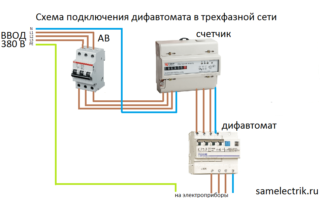 A three-phase network with a voltage of 380 V is organized in shops, garages, industrial premises. In order to correctly and quickly connect a protective difavtomat, it is necessary to take into account the algorithm for a line of 220 V.
A three-phase network with a voltage of 380 V is organized in shops, garages, industrial premises. In order to correctly and quickly connect a protective difavtomat, it is necessary to take into account the algorithm for a line of 220 V.
The wires are connected by clamping terminals according to the markings on the device body:
- the phase conductor is indicated by the letter L;
- neutral cable is marked as N;
- to indicate the lead conductor, the number 1 is used;
- the outlet wire is indicated by the number 2.
The electrical circuit for the three-phase line must have a ground conductor.
Nuances of installing selective models
The use of selective difavtomat as a main device is permissible only in a two-level scheme. The device marked S has a longer response time and deactivates second-level devices without disconnecting the line.
Selective devices can be connected as follows:
- leakage current is fixed by two level automatic devices operating according to the principle of randomness;
- if the response time of the main AEDT is longer, the second-level device is triggered first;
- in the event of a breakdown, one circuit is de-energized, the rest of the line is energized.
The principle of selectivity ensures the use of difavtomats with a similar threshold for current leakage.
Reminder for connecting a differential machine
Regardless of the number of network phases, you need to know how to connect the machine correctly:
- Power cables pop up at the top, wires to consumers at the bottom. In order not to get confused, you can see the type of connector and the circuitry on the AB case.
- Long cables should be replaced or increased so that the device does not burn out.
- Compliance with the polarity of the contacts ensures the correct response of the machine to network failures.
- Zero contacts are not connected to a common jumper. A neutral should only feed its own branch.
- The temperature range of operation of automatic machines is 6-34 degrees. When installing outdoors, models with a moisture-resistant housing are used.
- In an apartment or house remote from the substation, modifications are made with a breaking capacity of 6000 Amps, next to the substations - for 1000 A. If the place of residence is a village with an overhead power line, the device will last for 4,500 A.
The device can be turned over on a din-rail and photographed so as not to get confused in the future.
Connection algorithm
Step-by-step process of connecting circuit breakers in the apartment switchboard:
- Visual inspection of the device case for defects.
- De-energize the apartment switchboard by pressing the switch down.
- Check the absence of voltage of all contacts with an indicator screwdriver.
- Fixing the machine on the mounting rail with a latch on the back of the case.
- Removing the insulation coating of conductors with side cutters.
- Pressure testing of open ends with sleeves.
- The phase and neutral connections are from the power cable to the upper terminals and from the selected network to the lower terminals.
At the end of the work, you will need to turn on the voltage and test the machine.
Popular connection errors AVDT
After installation, the difavtomat may not turn on or immediately knock out. Errors of novice masters lead to similar phenomena:
- Combining protective zero (earth) and working zero (neutral) in a separate area. The device does not turn on, the handle at the top does not lock.
- The use of zero load for lower-level machines not from the output, but from the zero bus. The circuit breakers are brought into working position, but they turn off when the load is applied.
- The zero at the output is not output to the load, but returns to the bus. Zero load taken from the tire. The circuit breakers are in the working position, after pressing the test key, the difavtomat turns off.
- The cable from the zero bus goes to the lower terminal with the letter N, the wire does not go to the load. With active circuit breakers, the Test button does not work, operation is possible when voltage is applied.
- The neutrals of the two instruments are mixed up. Both are activated, the test button works. When a load is applied, both diflavomats are switched off.
- The connection of zeros from two machines in any section. The circuit breakers rise, but when you press the test key of one device or apply a load, both are turned off.
To fix the failures, you will need to reconnect.
Independent connection of a protective differential automaton will not be difficult for a person with skills who follows the scheme. A memo and a list of basic connection errors will help to avoid malfunctions in the device.

